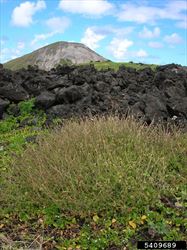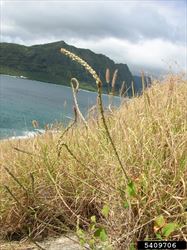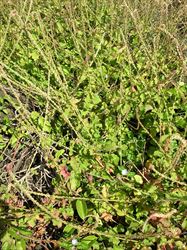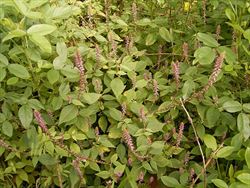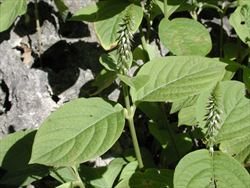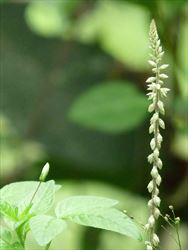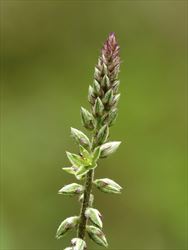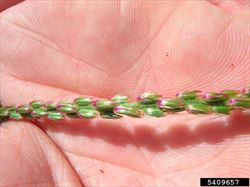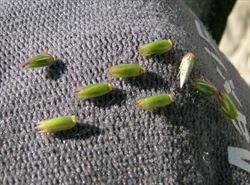Devil's horsewhip; it is also known as burweed, prickly chaff flower, rough chaff flower.
Pacific Pests, Pathogens, Weeds & Pesticides - Online edition
Pacific Pests, Pathogens, Weeds & Pesticides
Devil's horse whip (512)
Achyranthes aspera. It is a member of the Amaranthaceae.
Asia, Africa, North (Hawaii, Florida), South and Central America, the Caribbean, Europe (restricted), Oceania, It is recorded from Australia, American Samoa, Cook Islands, Federated States of Micronesia, Fiji, French Polynesia, Guam, Kiribati, Marshall Islands, New Caledonia, Niue, Northern Mariana Islands, Palau, Papua New Guinea, Pitcairn, Samoa, Solomon Islands, Timor-Leste, Tonga, Tuvalu, Vanuatu, Wallis and Futuna. Likely, a native of Southeast Asia, and/or Africa.
An annual, but often perennial, invasive weed (especially in Pacific island countries) growing in a wide range of habitats. Forms coastal thickets on rocky shores and sandunes (Photos 1-4), but also found on disturbed and cultivated land, roadsides, along fences, grasslands, woodlands, margins of forests. A weed of pastures. In Pacific islands, it has escaped cultivation to become invasive. It occurs from the coast to at least 2000 m (possbily more in Asia).
Stems erect, much branched, hairy, green with pinkish nodes, squarish, becoming woody below, growing to 2 m, occasionally taller, almost tree-like. Leaves, opposite along the stem, oval, up to 10 cm long, hairy, pointed at both ends, on leaf stalks up to 1.5 cm (Photos 5&6). Inflorescence (collection of flowers) on erect spikes, up to 60 cm long (Photo 7). Individual flowers, small, with five white or pink petal-like structures (called tepals), and leaf-like bracts below (Photos 8&9). As the flowers age they press closely agaist the stem, and as the fruits form, the bracts remain and develop sharp, pointed tips (Photos 10&11). The weed has a long tap root.
The long spines of the bracts get caught in the fur of animals, especially livestock, feathers of birds, or clothes and shoes of humans.
A weed with negative economic and environmental (biodoversity) impacts. CABI lists it is a weed of cotton, wheat and legumes (Vigna species). It is also said to be a problem in shaded pastures in East Africa.
Used as a greens on its own or with other vegtables and seeds; also, a long history of use as a folk medicine - as a diuetic, antispasmodic, emetic, for a range of ailments, e.g., boils diarrhoea, dysentery. The root is used especially. It is also used as a diuetic in vetinary medicine.
BIOSECURITY
Aschyranthes aspera has a very wide distribution in the tropics so countries not yet infested are very vulnerable to its introduction. Consequently, they should consider all likely pathways for entry, and apply quarantine measures accordingly. Particular attention should be given to the ease with which the spiny fruits attach to clothes, including shoes, and to fur and feathers. Additionally, the plant is widely used in traditional medicines and the fact that seed could be sent across international borders is a concern. Seed is available for purchase on the Internet.
A declared noxious weed in South Africa - prohibited plant that must be controlled - of no economic use and has characteristics harmful to humans, animal and the environment.
BIOCONTROL
No natural enemies have been identified.
CULTURAL CONTROL
- Physical & Mechanical:
- Hand weeding (and hoeing) is effective on small areas where follow-up is possible to control seedlings. Best to begin when plants are young, before seed production.
- Slashing is effective in order to encourage less-invasive species. It will need to be done regulalry.
- Mulching:
- Maintain a layer of mulch. Use a 5-10 cm layer of woodchips, grass clippings, etc.
- Hygiene:
- Treat vehicles and farm machinery. If moving from areas where the weed occurs to those weed-free, wash to remove soil and seed. This is equally important if the machinery is being imported into a country or moved within a country.
- If practical, check clothing for seeds after working in an infested area; fence infestations before attempting treatments to prevent further spread by wild animals and livestock.
CHEMICAL
In Fiji, a number of recomendations have been made, including: glyphosate, 2,4-D, dicamba, MCPA.
--------------------
Note, EU approval to use glyphosate ends in December 2022; its use after that date is under discussion.
____________________
When using a pesticide, always wear protective clothing and follow the instructions on the product label, such as dosage, timing of application, and pre-harvest interval. Recommendations will vary with the crop and system of cultivation. Expert advice on the most appropriate herbicides to use should always be sought from local agricultural authorities.
AUTHORS Grahame Jackson & Makereta Ranadi
Information from Achyranthes aspera (Devil's Horsewhip). BioNET-EAFRINET. (https://keys.lucidcentral.org/keys/v3/eafrinet/weeds/key/weeds/Media/Html/Achyranthes_aspera_(Devils_Horsewhip).htm); and CABI Achyranthes aspera (devil's horsewhip) (2021) Crop Protection Compendium. (https://www.cabi.org/cpc/datasheet/2664); and Achyranthes aspera L., Amaranthaceae. Pacific island ecosystems at risk (PIER). (http://www.hear.org/pier/species/achyranthes_aspera.htm); Achyranthes asoera (2021) Wikipedia. (https://en.wikipedia.org/wiki/Achyranthes_aspera); and from Fern K (2021) Cleome viscosa L. Tropical Plants Database. (https://tropical.theferns.info/viewtropical.php?id=Achyranthes+aspera). Photos 1-4 Forest and Kim Starr. Starr Environmental. Bugwood.org. Photo 5 Frank Vincentz (2008) Achyranthes aspera. Growing in Puntallana, La Palma, Canary Islands. (https://commons.wikimedia.org/wiki/File:Achyranthes_aspera_(Puntallana)_01_ies.jpg). Photos 6&7 Gerald McCormack. Cook Islands Biodiversity. (http://cookislands.bishopmuseum.org/results.asp?ebg=achyranthes&Submit=Search&search=true). (Photos 8&9 Jee & Rani (2010 ) Nature Photography. Creative Commons Attribution-ShareAlike 4.0 International License. Wikimedia Commons. (https://commons.wikimedia.org/wiki/File:Achyranthes_aspera_at_Kadavoor.jpg). Photos 10&11 Forrest and Kim Starr (2013) Seedhead & Spiny seeds stuck to gloves (respectively). (https://www.flickr.com/search/?text=Achyranthes%20aspera).
Produced with support from the Australian Centre for International Agricultural Research under project HORT/2016/185: Responding to emerging pest and disease threats to horticulture in the Pacific islands, implemented by the University of Queensland, in association with the Pacific Community and Koronivia Research Station, Ministry of Agriculture, Fiji.
